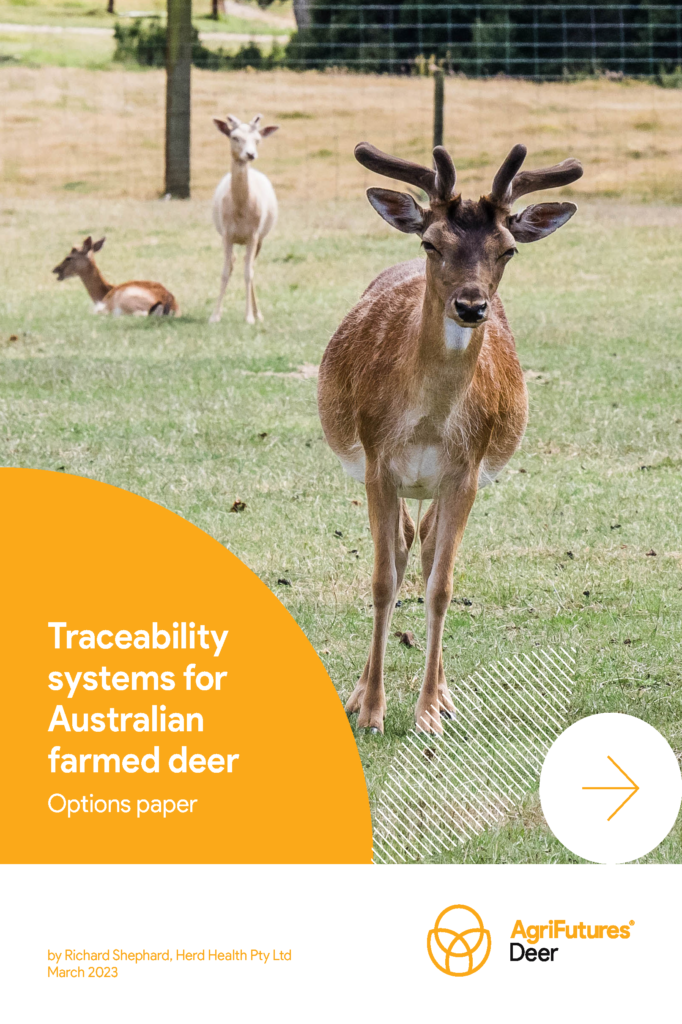The Australian farmed deer industry does not currently mandate the use of animal identification (ID) or movement traceability. Deer are susceptible to foot and mouth disease (FMD) and the heightened awareness of FMD arising from the recent outbreak in Indonesia has focused attention on readiness of each FMD-susceptible industry. The cattle, sheep, goat and pig industries have mandated animal ID and traceability schemes operating that require: (1) identification of all contact animals and properties associated with a suspect case from the preceding 30-day period, within 24 hours of the suspect case being declared; (2) identification of all properties associated with the suspect within 14 days of the suspect case being declared; and (3) identification of all contact animals associated with the suspect animal (or the properties that the contact animal was identified to have occupied in its lifetime) within 30 days of the suspect case being declared.
Recent reviews have identified mob-based sheep ID and traceability systems as unlikely to meet these performance standards (especially lifetime property and individual animal contact history). A recommendation for a nationally administered, universal (multi-species), individual animal electronic identification (eID) and traceability system has so far not progressed beyond cattle; however, inclusion plans for sheep and goats in 2025 have been announced. The Australian farmed deer industry appears to be the least capable industry among FMD-susceptible species industries of providing effective animal ID and traceability capabilities. This presents a risk to Australia’s biosecurity and agricultural trade.
The farmed deer industry in Australia has unique features that potentially influence the choice of an industry-managed animal ID and traceability system. The industry is small and shrinking, and has no central register of producers (or deer). Deer are farmed for velvet (mostly red deer), venison (mostly fallow deer) or both. Venison stags can produce for 10–12 years. There is a limited number of abattoirs that process deer (only two with export licences).
Recent changes have allowed wild-caught (i.e. shot feral) venison to be sold into the consumer market, mostly via restaurants. Farmed deer have strict boundary fencing requirements. This is to prevent escapes and potential establishment of more feral deer populations, and to prevent contact between feral and farmer deer populations, which could potentially spread disease. There is very limited farmed deer movement—almost none between farms (stags are usually home-bred)—most being from farm of birth to processor (abattoir). There are no deer saleyards and no significant ‘deer trading’ market (e.g. backgrounding, finishing; most deer are sent for slaughter from their farm of birth). This means the movement of deer in Australia (and the risk disease spread) is simpler and easier to follow than the movement of cattle or sheep.
This report recommends the Deer Industry Association of Australia (DIAA) and AgriFutures Australia form a working group to review any necessary governance structures and explore the feasibility of an Australian farmed deer animal identification and traceability system compatible with national animal ID and traceability objectives. This would likely involve a review of industry (farmers, locations, farm sizes and characteristics), evaluation of capability of developing and managing a central register of farms and farmers, quantifying farm-level drivers for traceability (especially to identify resistance points for regulatory impost), estimating traceability establishment fixed costs (e.g. tag manufacturer tooling, registry establishment etc.), exploring funding options for delivery (including communications to members, government and the supply chain), establishment of a governance system (including administration of the traceability systems and their agreed rules), and discussion with Integrity Systems Company, which manages the National Livestock Identification System (NLIS) database, and with government to explore pathways for deployment of an electronic ID and traceability system.
The low frequency and rate of movement of farmed deer to and from farms suggests that, as an interim solution, a mob-based ‘waybill’ style animal ID and traceability system may provide most of the required functionality for industry. A paper-based system alone is insufficient for identifying contacts and their movements from a suspect case and, as such, is not suitable for exotic disease control preparedness. While an NLIS—using individual-animal eID tags, compulsory registering of all animals and their movements between properties—would meet the emergency animal disease (EAD) preparedness requirements of an FMD-susceptible species, the Australian farmed deer industry is not yet able to fund such a complex and costly system without external assistance. There are increased calls by animal production industries and by government for a central, multi-species animal-based eID and movement system to support a coordinated response to animal disease outbreaks. This will be an important aspect for the proposed working group to review. Any evaluation should consider the merit or otherwise of implementing cheaper (but non-eID) solutions as an interim solution.





